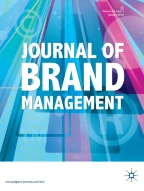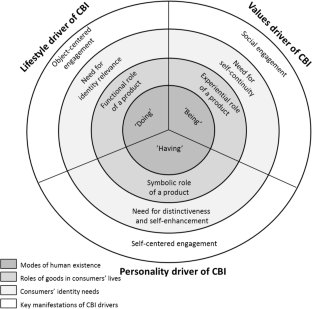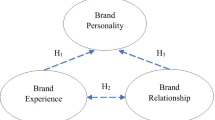Understanding the drivers of consumer–brand identification

The purpose of this study is to develop a holistic understanding of the drivers of consumer–brand identification (CBI) from a consumer’s perspective, in other words, to explicate why and how consumers form identity-based connections with brands. In this conceptual study, the drivers of CBI are discussed by weaving together different perspectives presented in the extensive literature on identity-based consumer behaviour. The study at hand conceptualizes the drivers of CBI by acknowledging consumer’s personality, life tasks and life values together with brand personality, brand promise and brand community as the main factors underlying the realization of a self-brand connection. The paper presents different scenarios for consumer–brand identification and related managerial implications. The study distinguishes three drivers of CBI: (1) the personality driver, (2) the lifestyle driver and (3) the values driver. A call is made for empirical studies that would examine the significance of each driver of CBI in differing contexts and product categories. The challenges to and possibilities for brand identity management are addressed. The study challenges the different schools of thought prevalent in contemporary brand management literature in approaching the drivers of CBI more holistically.
This is a preview of subscription content, log in via an institution to check access.
Access this article
Subscribe and save
Springer+ Basic
€32.70 /Month
- Get 10 units per month
- Download Article/Chapter or eBook
- 1 Unit = 1 Article or 1 Chapter
- Cancel anytime
Buy Now
Price includes VAT (France)
Instant access to the full article PDF.
Rent this article via DeepDyve

Similar content being viewed by others

Revitalizing the non-profit brand personality through brand experience and brand relationship dimensions
Article 02 October 2021

Brand Relationships Rule
Chapter © 2015
Connecting the dots between brand experience and brand loyalty: The mediating role of brand personality and brand relationships
Article 24 October 2014
References
- Aaker, J. 1997. Dimensions of brand personality. Journal of Marketing Research 34(3): 347–356. ArticleGoogle Scholar
- Aaker, J., S. Fournier, and S.A. Brasel. 2004. When good brands do bad. Journal of Consumer Research 31(June): 1–16. ArticleGoogle Scholar
- Ahuvia, A.C. 2005. Beyond the extended self: Loved objects and consumers’ identity narratives. Journal of Consumer Research 32(1): 171–184. ArticleGoogle Scholar
- Albert, N., D. Merunka, and P. Valette-Florence. 2013. Brand passion: Antecedents and consequences. Journal of Business Research 66(7): 904–909. ArticleGoogle Scholar
- Algesheimer, R., U.M. Dholakia, and A. Herrmann. 2005. The social influence of brand community: Evidence from European car clubs. Journal of Marketing 69(3): 19–34. ArticleGoogle Scholar
- Ashforth, B.E., S.H. Harrison, and K.G. Corely. 2008. Identification in organizations: An examination of four fundamental questions. Journal of Management 34(3): 325–374. ArticleGoogle Scholar
- Ball, A.D., and L.H. Tasaki. 1992. The role and measurement of attachment in consumer behavior. Journal of Consumer Psychology 1(2): 155–172. ArticleGoogle Scholar
- Bandura, A. 2001. Social cognitive theory of mass communication. Media Psychology 3(3): 265–299. ArticleGoogle Scholar
- Batra, R., A. Ahuvia, and R.P. Bagozzi. 2012. Brand love. Journal of Marketing 76(2): 1–16. ArticleGoogle Scholar
- Baumgartner, H. 2002. Toward a personology of the consumer. Journal of Consumer Research 29(2): 286–292. ArticleGoogle Scholar
- Bell, D., and J. Hollows. 2005. Making sense of ordinary lifestyles. In Ordinary lifestyles, ed. D. Bell and J. Hollows, 21–34. Maidenhead, Berkshire: Open University Press. Google Scholar
- Berthon, P., M.B. Holbrook, J.M. Hulbert, and L. Pitt. 2007. Viewing brands in multiple dimensions. MIT Sloan Management Review 48(2): 37–43. Google Scholar
- Beverland, M. 2005. Brand management and the challenge of authenticity. Journal of Product and Brand Management 14(7): 460–461. ArticleGoogle Scholar
- Bhattacharya, C.B., and S. Sen. 2003. Consumer-company identification: A framework for understanding consumers’ relationships with companies. Journal of Marketing 67(2): 76–88. ArticleGoogle Scholar
- Bowden, J. 2009. Customer engagement: A framework for assessing customer-brand relationships: The case of the restaurant industry. Journal of Hospitality Marketing & Management 18(6): 574–596. ArticleGoogle Scholar
- Carroll, B.A., and A.C. Ahuvia. 2006. Some antecedents and outcomes of brand love. Marketing Letters 17(2): 79–89. ArticleGoogle Scholar
- Chernev, A., R. Hamilton, and D. Gal. 2011. Competing for consumer identity: Limits to self-expression and the perils of lifestyle branding. Journal of Marketing 75(3): 66–82. ArticleGoogle Scholar
- Deaux, K. 1992. Personalizing identity and socializing self. In Social psychology of identity and the self concept, ed. G.M. Breakwell, 9–33. London: Surrey University Press. Google Scholar
- DeChernatory, L. 1999. Brand management through narrowing the gap between brand identity and brand reputation. Journal of Marketing Management 15(1–3): 157–179. ArticleGoogle Scholar
- de Lencastre, P., and A. Côrte-Real. 2010. A brand triangle model to avoid branding myopia. The IUP Journal of Brand Management 7(1&2): 76–91. Google Scholar
- Donavan, D.T., S. Janda, and J. Suh. 2006. Environmental influences in corporate brand identification and outcomes. Journal of Brand Management 14(1/2): 125–136. ArticleGoogle Scholar
- Eisend, M., and N. Stokburger-Sauer. 2013. Brand personality: A meta-analytic review of antecedents and consequences. Marketing Letters 24(3): 205–216. ArticleGoogle Scholar
- Escalas, J.E. 2004. Narrative processing: Building consumer connections to brands. Journal of Consumer Psychology 4(1&2): 168–180. ArticleGoogle Scholar
- Fournier, S. 1991. A meaning-based framework for the study of consumer-object relations. Advances in Consumer Research 18(1): 736–742. Google Scholar
- Fournier, S. 1998. Consumers and their brands: Developing relationship theory in consumer research. Journal of Consumer Research 24(4): 343–373. ArticleGoogle Scholar
- Fromm, E. 1976. To have or to be.(Republished in 1997). New York: Continuum.
- Gambetti, R.C., G. Graffigna, and S. Biraghi. 2012. The grounded theory approach to consumer-brand engagement. International Journal of Market Research 54(5): 659–687. ArticleGoogle Scholar
- Gentry, J., S.M. Baker, and F.B. Kraft. 1995. The role of possessions in creating, maintaining, and preserving one’s identity: Variation over the life course. Advances in Consumer Research 22(1): 413–418. Google Scholar
- Giddens, A. 1991. Modernity and self-identity: Self and society in the late modern age. Stanford, CA: Stanford University Press. Google Scholar
- Gómez-Suárez, M., M.P. Martínez-Ruiz, and N. Martínez-Caraballo. 2017. Consumer-brand relationships under the marketing 3.0 paradigm: A literature review. Frontiers in Psychology 8: 1–4. ArticleGoogle Scholar
- Halkoaho, J. 2012. Identity-related media consumption: A focus on consumers’ relationships with their favourite TV programs. PhD Thesis. Vaasa: University of Vaasa Press.
- Hollebeek, L. 2011. Exploring customer brand engagement: Definition and themes. Journal of Strategic Marketing 19(7): 555–573. ArticleGoogle Scholar
- Holt, D. 2002. Why do brands cause trouble? A dialectical theory of consumer culture and branding. Journal of Consumer Research 29(1): 70–90. ArticleGoogle Scholar
- Huffman, C., S. Ratneshwar, and D.G. Mick. 2000. Consumer goal structures and goal-determination processes: An integrative framework. In The why of consumption. Contemporary perspectives on consumer motives, goals, and desires, ed. S. Ratneshwar, D.G. Mick, and C. Huffman, 9–35. London: Routledge. Google Scholar
- Kirmani, A. 2009. The self and the brand. Journal of Consumer Psychology 9(3): 271–275. ArticleGoogle Scholar
- Kleine, S.Schultz, R.E. Kleine III, and C.T. Allen. 1995. How is a possession “me” or “not me”? Characterizing types and antecedent of material possession attachment. Journal of Consumer Research 22(3): 327–343. ArticleGoogle Scholar
- Kressmann, F., M.J. Sirgy, A. Herrmann, F. Huber, and D.-J. Lee. 2006. Direct and indirect effects of self-image congruence on brand loyalty. Journal of Business Research 59(9): 955–964. ArticleGoogle Scholar
- Kuenzel, S., and S.V. Halliday. 2008. Investigating antecedents and consequences of brand identification. Journal of Product & Brand Management 17(5): 293–304. ArticleGoogle Scholar
- Lam, S.K., M. Ahearne, R. Mullins, B. Hayati, and N. Schillewaert. 2013. Exploring the dynamics of antecedents to consumer-brand identification with a new brand. Journal of the Academy of Marketing Science 41(2): 234–252. ArticleGoogle Scholar
- Lam, S.K., M. Ahearne, and N. Schillewaert. 2012. A multinational examination of the symbolic-instrumental framework of consumer-brand identification. Journal of International Business Studies 43(3): 306–331. ArticleGoogle Scholar
- MacInnis, D.J. 2011. A framework for conceptual contributions in marketing. Journal of Marketing 75(July): 136–154. ArticleGoogle Scholar
- Maehle, N., C. Otnes, and M. Supphellen. 2011. Consumers’ perceptions of the dimensions of brand personality. Journal of Consumer Behavior 10(5): 290–303. ArticleGoogle Scholar
- Mael, F., and B.E. Ashforth. 1992. Alumni and their alma mater: A partial test of the reformulated model of organizational identification. Journal of Organizational Behavior 13(2): 103–123. ArticleGoogle Scholar
- Malär, L., H. Krohmer, W.D. Hoyer, and B. Nyffenegger. 2011. Emotional brand attachment and brand personality: The relative importance of the actual and the ideal self. Journal of Marketing 75(4): 35–52. ArticleGoogle Scholar
- Mathews, J. 2015. Brand personality: Finding compatibility between human personality and brand characteristics. The IUP Journal of Brand Management 12(2): 21–38. Google Scholar
- Matusitz, J. 2014. Symbolism in terrorism: Motivation, communication, and behavior. Lanham, MD: Rowman & Littlefield. Google Scholar
- McAdams, D.P. 1996. Personality, modernity, and the storied self: A contemporary framework for studying persons. Psychological Inquiry 7(4): 295–321. ArticleGoogle Scholar
- McAlexander, J.H., J.W. Schouten, and H.F. Koenig. 2002. Building brand community. Journal of Marketing 66(1): 38–54. ArticleGoogle Scholar
- Miles, S. 2000. Youth lifestyles in a changing world. Buckingham: Open University Press. Google Scholar
- Millán, Á., and E. Díaz. 2014. Analysis of consumers’ response to brand community integration and brand identification. Journal of Brand Management 21(3): 254–272. ArticleGoogle Scholar
- Muniz, A.M., and T.C. O’Guinn. 2001. Brand community. Journal of Consumer Research 27(4): 412–432. ArticleGoogle Scholar
- Nandan, S. 2005. An exploration of the brand identity—Brand image linkage: A communications perspective. Journal of Brand Management 12(4): 264–279. ArticleGoogle Scholar
- O’Cass, A. 2000. An assessment of consumers’ product, purchase decision, advertising and consumption involvement in fashion clothing. Journal of Economic Psychology 21: 545–576. ArticleGoogle Scholar
- O’Cass, A. 2004. Fashion clothing consumption: Antecedents and consequences of fashion clothing involvement. European Journal of Marketing 38(7): 869–882. ArticleGoogle Scholar
- Ogilvie, D.M., and K.M. Rose. 1995. Self-with-other representations and a taxonomy of motives: Two approaches to studying persons. Journal of Personality 63(3): 643–679. ArticleGoogle Scholar
- Oyserman, D. 2009. Identity-based motivation: Implications for action-readiness, procedural-readiness, and consumer behavior. Journal of Consumer Psychology 19(3): 250–260. ArticleGoogle Scholar
- Papista, E., and S. Dimitriadis. 2012. Exploring consumer-brand relationship quality and identification: Qualitative evidence from cosmetics brands. Qualitative Market Research: An International Journal 15(1): 33–56. ArticleGoogle Scholar
- Park, C.W., B.J. Jaworski, and D.J. MacInnis. 1986. Strategic brand concept-image management. Journal of Marketing 50(4): 134–145. ArticleGoogle Scholar
- Quester, P., and A.L. Lim. 2003. Product involvement/brand loyalty: Is there a link? Journal of Product and Brand Management 12(1): 22–38. ArticleGoogle Scholar
- Reed II, A. 2002. Social identity as a useful perspective for self-concept-based consumer research. Psychology & Marketing 19(3): 235–266. ArticleGoogle Scholar
- Reed II, A., M.R. Forehand, S. Puntoni, and L. Warlop. 2012. Identity-based consumer behavior. International Journal of Research in Marketing 29(4): 310–321. ArticleGoogle Scholar
- Sartre, J.-P. 1966. Being and nothingness: An essay on phenomenological ontology. New York: Pocket Books. Google Scholar
- Schau, H.J., A.M. Muñiz, and E.J. Arnould. 2009. How brand community practices create value. Journal of Marketing 73(5): 30–51. ArticleGoogle Scholar
- Schmitt, B. 2012. The consumer psychology of brands. Journal of Consumer Psychology 22: 7–17. ArticleGoogle Scholar
- Schultz, S.E., R.E. Kleine III, and J.B. Kernan. 1989. ‘These are a few of my favorite things’ Toward an explication of attachment as a consumer behavior construct. Advances in Consumer Research 16(1): 359–366. Google Scholar
- Shankar, A., and J.A. Fitchett. 2002. Having, being and consumption. Journal of Marketing Management 18(5/6): 501–516. ArticleGoogle Scholar
- Sirgy, M.J. 1982. Self-concept in consumer behavior: A critical review. Journal of Consumer Research 9(3): 287–300. ArticleGoogle Scholar
- Sivadas, E., and R. Venkatesh. 1995. An examination of individual and object-specific influences on the extended self and its relation to attachment and satisfaction”. Advances in Consumer Research 22(1): 406–412. Google Scholar
- Smit, E., F. Bronner, and M. Tolboom. 2007. Brand relationship quality and its value for personal contact. Journal of Business Research 60(6): 627–633. ArticleGoogle Scholar
- Sprott, D., S. Czellar, and E. Spangenberg. 2009. The importance of a general measure of brand engagement on market behavior: Development and validation of a scale. Journal of Marketing Research 46(1): 92–104. ArticleGoogle Scholar
- Stokburger-Sauer, N., S. Ratneshwar, and S. Sen. 2012. Drivers of consumer-brand identification. International Journal of Research in Marketing 29(4): 406–418. ArticleGoogle Scholar
- Sung, Y., and J. Kim. 2010. Effects of brand personality on brand affect and brand trust. Psychology & Marketing 27(7): 639–661. ArticleGoogle Scholar
- Swaminathan, V., K.L. Page, and Z. Gürhan-Canli. 2007. ‘My’ brand or ‘our’ brand: The effects of brand relationship dimensions and self-construal on brand evaluations. Journal of Consumer Research 34(2): 248–259. ArticleGoogle Scholar
- Swaminathan, V., K.M. Stilley, and R. Ahluwalia. 2009. When brand personality matters: The moderating role of attachment styles. Journal of Consumer Research 35(6): 985–1002. ArticleGoogle Scholar
- Story, J., and J. Hess. 2006. Segmenting customer-brand relations: Beyond the personal relationship metaphor. Journal of Consumer Marketing 23(7): 406–413. ArticleGoogle Scholar
- Thompson, C.J., and Z. Arsel. 2004. The Starbucks brandscape and consumers’ (anticorporate) experiences of glocalization. Journal of Consumer Research 31(3): 631–642. ArticleGoogle Scholar
- Thompson, C.J., A. Rindfleisch, and Z. Arsel. 2006. Emotional branding and the strategic value of the doppelgänger brand image. Journal of Marketing 70(1): 50–64. ArticleGoogle Scholar
- Thomson, M., D.J. MacInnis, and C.W. Park. 2005. The ties that bind: Measuring the strength of consumers’ emotional attachments to brands. Journal of Consumer Psychology 15(1): 77–91. ArticleGoogle Scholar
- Tuškej, U., U. Golob, and K. Podnar. 2013. The role of consumer-brand identification in building brand relationships. Journal of Business Research 66(1): 53–59. ArticleGoogle Scholar
- Urminsky, O., D.M. Bartels, P. Giuliano, G.E. Newman, S. Puntoni, and L. Rips. 2014. Choice and self: How synchronic and diachronic identity shape choices and decision making. Marketing Letters 25(3): 281–291. ArticleGoogle Scholar
- Wallendorf, M., and E. Arnould. 1988. ‘My favorite things’: A cross-cultural inquiry into object attachment, possessiveness, and social linkage. Journal of Consumer Research 14(4): 531–547. ArticleGoogle Scholar
- Wattanasuwan, K. 2005. The self and symbolic consumption. The Journal of American Academy of Business, Cambridge 6(1): 179–184. Google Scholar
- Zaichkowsky, J.L. 2010. Strategies for distinctive brands. Journal of Brand Management 17(8): 548–560. ArticleGoogle Scholar
Author information
Authors and Affiliations
- Department of Economics and Management, University of Helsinki, Post Box 27, 00014, University of Helsinki, Finland Jenniina Sihvonen
- Jenniina Sihvonen
You can also search for this author in PubMed Google Scholar
Corresponding author
Ethics declarations
Conflict of interest
The author states that there is no conflict of interest.
Additional information
Publisher's Note
Springer Nature remains neutral with regard to jurisdictional claims in published maps and institutional affiliations.
Rights and permissions
About this article
Cite this article
Sihvonen, J. Understanding the drivers of consumer–brand identification. J Brand Manag 26, 583–594 (2019). https://doi.org/10.1057/s41262-018-00149-z
- Revised : 05 January 2017
- Published : 19 January 2019
- Issue Date : 01 September 2019
- DOI : https://doi.org/10.1057/s41262-018-00149-z
Share this article
Anyone you share the following link with will be able to read this content:
Get shareable link
Sorry, a shareable link is not currently available for this article.
Copy to clipboard
Provided by the Springer Nature SharedIt content-sharing initiative
Keywords
- Consumer–brand identification
- Brand relationship
- Lifestyle
- Values
- Brand personality



